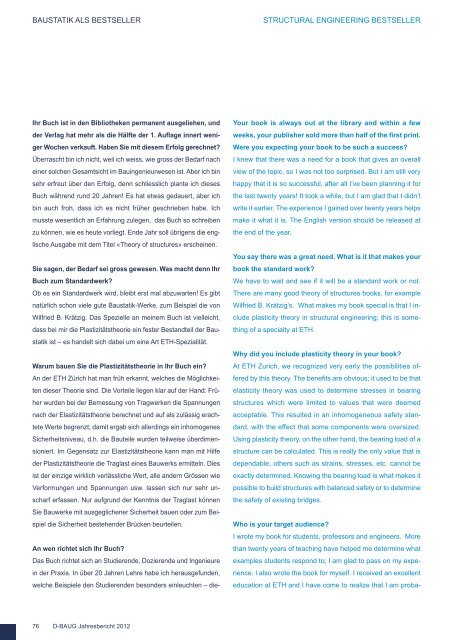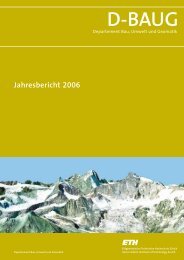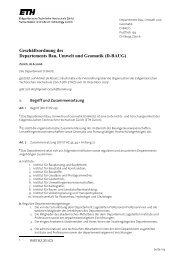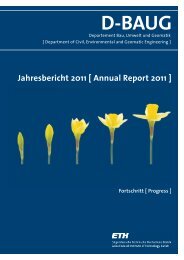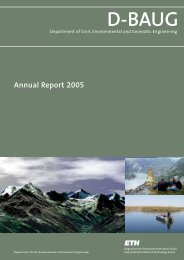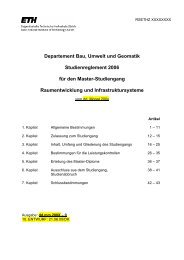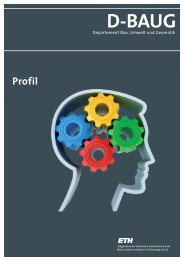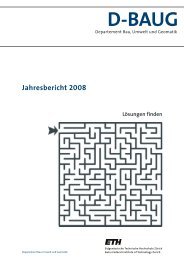Annual Report 2012 - Departement Bau, Umwelt und Geomatik ...
Annual Report 2012 - Departement Bau, Umwelt und Geomatik ...
Annual Report 2012 - Departement Bau, Umwelt und Geomatik ...
- Keine Tags gefunden...
Sie wollen auch ein ePaper? Erhöhen Sie die Reichweite Ihrer Titel.
YUMPU macht aus Druck-PDFs automatisch weboptimierte ePaper, die Google liebt.
BAUSTATIK ALS BESTSELLER<br />
STRUCTURAL ENGINEERING BESTSELLER<br />
Ihr Buch ist in den Bibliotheken permanent ausgeliehen, <strong>und</strong><br />
der Verlag hat mehr als die Hälfte der 1. Auflage innert weniger<br />
Wochen verkauft. Haben Sie mit diesem Erfolg gerechnet<br />
Überrascht bin ich nicht, weil ich weiss, wie gross der Bedarf nach<br />
einer solchen Gesamtsicht im <strong>Bau</strong>ingenieurwesen ist. Aber ich bin<br />
sehr erfreut über den Erfolg, denn schliesslich plante ich dieses<br />
Buch während r<strong>und</strong> 20 Jahren! Es hat etwas gedauert, aber ich<br />
bin auch froh, dass ich es nicht früher geschrieben habe. Ich<br />
musste wesentlich an Erfahrung zulegen, das Buch so schreiben<br />
zu können, wie es heute vorliegt. Ende Jahr soll übrigens die englische<br />
Ausgabe mit dem Titel «Theory of structures» erscheinen.<br />
Sie sagen, der Bedarf sei gross gewesen. Was macht denn Ihr<br />
Buch zum Standardwerk<br />
Ob es ein Standardwerk wird, bleibt erst mal abzuwarten! Es gibt<br />
natürlich schon viele gute <strong>Bau</strong>statik-Werke, zum Beispiel die von<br />
Wilfried B. Krätzig. Das Spezielle an meinem Buch ist vielleicht,<br />
dass bei mir die Plastizitätstheorie ein fester Bestandteil der <strong>Bau</strong>statik<br />
ist – es handelt sich dabei um eine Art ETH-Spezialität.<br />
Warum bauen Sie die Plastizitätstheorie in Ihr Buch ein<br />
An der ETH Zürich hat man früh erkannt, welches die Möglichkeiten<br />
dieser Theorie sind. Die Vorteile liegen klar auf der Hand: Früher<br />
wurden bei der Bemessung von Tragwerken die Spannungen<br />
nach der Elastizitätstheorie berechnet <strong>und</strong> auf als zulässig erachtete<br />
Werte begrenzt; damit ergab sich allerdings ein inhomogenes<br />
Sicherheitsniveau, d.h. die <strong>Bau</strong>teile wurden teilweise überdimensioniert.<br />
Im Gegensatz zur Elastizitätstheorie kann man mit Hilfe<br />
der Plastizitätstheorie die Traglast eines <strong>Bau</strong>werks ermitteln. Dies<br />
ist der einzige wirklich verlässliche Wert, alle andern Grössen wie<br />
Verformungen <strong>und</strong> Spannungen usw. lassen sich nur sehr unscharf<br />
erfassen. Nur aufgr<strong>und</strong> der Kenntnis der Traglast können<br />
Sie <strong>Bau</strong>werke mit ausgeglichener Sicherheit bauen oder zum Beispiel<br />
die Sicherheit bestehender Brücken beurteilen.<br />
An wen richtet sich Ihr Buch<br />
Das Buch richtet sich an Studierende, Dozierende <strong>und</strong> Ingenieure<br />
in der Praxis. In über 20 Jahren Lehre habe ich herausgef<strong>und</strong>en,<br />
welche Beispiele den Studierenden besonders einleuchten – die-<br />
Your book is always out at the library and within a few<br />
weeks, your publisher sold more than half of the first print.<br />
Were you expecting your book to be such a success<br />
I knew that there was a need for a book that gives an overall<br />
view of the topic, so I was not too surprised. But I am still very<br />
happy that it is so successful, after all I’ve been planning it for<br />
the last twenty years! It took a while, but I am glad that I didn’t<br />
write it earlier. The experience I gained over twenty years helps<br />
make it what it is. The English version should be released at<br />
the end of the year.<br />
You say there was a great need. What is it that makes your<br />
book the standard work<br />
We have to wait and see if it will be a standard work or not.<br />
There are many good theory of structures books, for example<br />
Wilfried B. Krätzig’s. What makes my book special is that I include<br />
plasticity theory in structural engineering; this is something<br />
of a specialty at ETH.<br />
Why did you include plasticity theory in your book<br />
At ETH Zurich, we recognized very early the possibilities offered<br />
by this theory. The benefits are obvious; it used to be that<br />
elasticity theory was used to determine stresses in bearing<br />
structures which were limited to values that were deemed<br />
acceptable. This resulted in an inhomogeneous safety standard,<br />
with the effect that some components were oversized.<br />
Using plasticity theory, on the other hand, the bearing load of a<br />
structure can be calculated. This is really the only value that is<br />
dependable, others such as strains, stresses, etc. cannot be<br />
exactly determined. Knowing the bearing load is what makes it<br />
possible to build structures with balanced safety or to determine<br />
the safety of existing bridges.<br />
Who is your target audience<br />
I wrote my book for students, professors and engineers. More<br />
than twenty years of teaching have helped me determine what<br />
examples students respond to; I am glad to pass on my experience.<br />
I also wrote the book for myself. I received an excellent<br />
education at ETH and I have come to realize that I am proba-<br />
76 D-BAUG Jahresbericht <strong>2012</strong>


